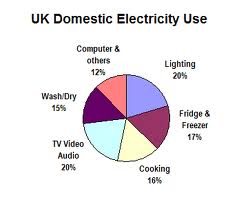 When we started looking at this question of which appliances use the most electricity, we thought that intuitively we knew what the answer would be. The oven, the furnace, pool pump and appliances with motors would be the heavy users. And yes these appliances are in fact heavy users of electricity; however they are not even close to the big one. It turns out that central air conditioning and heat pumps are the big consumers of electricity for two main reasons.
When we started looking at this question of which appliances use the most electricity, we thought that intuitively we knew what the answer would be. The oven, the furnace, pool pump and appliances with motors would be the heavy users. And yes these appliances are in fact heavy users of electricity; however they are not even close to the big one. It turns out that central air conditioning and heat pumps are the big consumers of electricity for two main reasons.
Appliances That Use The Most Electricity
First there are two electrical motors that are running when these appliances are in use and they are typically large motors that consume a lot of electricity, up to 15,000 watts on average per hour. On top of that we tend to run our air conditioners for a long time particularly if it is really hot compared to other appliances such as an electric range, a clothes dryer etc. They use a great deal of energy during the summer time.
The cost to run an air conditioner that is consuming 15,000 watts per hour during the day time during peak hours can be as much as $1.60 per hour; while at night when rates are lower the cost can decrease to around 75 cents per hour or half of the rate that is charged during the day. We are assuming 11 cents per kilowatt during the day and 6 cents during the evening.
Large Appliances vs. Light Bulbs
Clothes dryers will use 4000 watts per hour, while a hair dryer is down around 1200 watts and the incandescent light bulb is down around 60 watts. Electricity usage is all about the math. For example let’s assume the average home has 10 light bulbs, all incandescent and are on for an average of 3 hours per day. This amounts to 1800 watts per day or 13,600 watts per week. The dryer on the other hand might be used for 30 minutes several times a week, let’s assume 4 times per week. This calculates to 8000 watts of total usage over a weeks’ time. We all want to cut down on electrical usage and now you can understand why everyone wants to switch to fluorescent bulbs or LED bulbs which reduce the electrical usage significantly.
Detailed Usage Levels
The following chart attempts to hi-light the usage levels and costs of these appliances. You can vary your own assumptions; however we think that in general you will come out to the same conclusions. Note that for the incandescent lights are assumed to have 10 light bulbs that are on for 7 hours a day on average, for 7 days.
| Appliance | Avg Consumption per hour |
Cost/hour (10cents/KW) |
Hours per Week | Total Cost |
| Central Air Conditioner | 15,000 watts | $1.50 | 70 | $105.00 |
| Clothes Dryer | 4,000 watts | $0.40 | 5 | $2.00 |
| Water Pump | 3,000 watts | $0.30 | 5 | $1.50 |
| Space heater | 1,500 watts | $0.15 | 70 | $10.50 |
| Hair Dryer | 1,200 watts | $0.12 | 1.5 | $0.18 |
| Electric Range | 1,000 watts | $0.10 | 7 | $0.70 |
| Refrigerator | 1,000 watts | $0.10 | 70 | $0.70 |
| Desktop Computer | 400 watts | $0.04 | 70 | $0.28 |
| Incandescent bulb | 60 watts | $0.06 | 490 | $29.40 |
When you add in the number of hours of use on average every week, it really changes the picture. the air conditioner is of course the highest, but what is really surprising is the cost of leaving lights on that are incandescent. Switch to fluorescent and you can save a tremendous about of electricity.
Reduce Hours
Reduce the number of hours your air conditioner is running by turning up the temperature on your thermostat and you can significantly reduce the amount of electricity that you use. You might argue that the assumptions in terms of how may hours we assumed, however just substitute your own to calculate the cost. We do not think that the conclusions will change.
Pushing usage into lower rate times such as in the evening will have a huge impact as well. In summary here is how you can control or reduce your electrical usage and your cost for total electricity:
- Turn up the thermostat
- Cool the house in the evening when rates are lower
- Control usage so that it is primarily in the evening in low rate hours
- Turn off lights
- Switch from incandescent to fluorescent lights
- Focus on the higher cost appliances that you use a lot
January 1st, 2013 on 3:05 pm
this is really good information about appliances that use the most energy. I wonder if there is a business case for replacing some appliances for better efficient appliances.